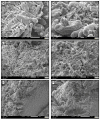The Type and Concentration of Inoculum and Substrate as Well as the Presence of Oxygen Impact the Water Kefir Fermentation Process
- PMID: 33643256
- PMCID: PMC7904701
- DOI: 10.3389/fmicb.2021.628599
The Type and Concentration of Inoculum and Substrate as Well as the Presence of Oxygen Impact the Water Kefir Fermentation Process
Abstract
Eleven series of water kefir fermentation processes differing in the presence of oxygen and the type and concentration of inoculum and substrate, were followed as a function of time to quantify the impact of these parameters on the kinetics of this process via a modeling approach. Increasing concentrations of the water kefir grain inoculum increased the water kefir fermentation rate, so that the metabolic activity during water kefir fermentation was mainly associated with the grains. Water kefir liquor could also be used as an alternative means of inoculation, but the resulting fermentation process progressed slower than the one inoculated with water kefir grains, and the production of water kefir grain mass was absent. Substitution of sucrose with glucose and/or fructose reduced the water kefir grain growth, whereby glucose was fermented faster than fructose. Lacticaseibacillus paracasei (formerly known as Lactobacillus paracasei), Lentilactobacillus hilgardii (formerly known as Lactobacillus hilgardii), Liquorilactobacillus nagelii (formerly known as Lactobacillus nagelii), Saccharomyces cerevisiae, and Dekkera bruxellensis were the main microorganisms present. Acetic acid bacteria were present in low abundances under anaerobic conditions and only proliferated under aerobic conditions. Visualization of the water kefir grains through scanning electron microscopy revealed that the majority of the microorganisms was attached onto their surface. Lactic acid bacteria and yeasts were predominantly associated with the grains, whereas acetic acid bacteria were predominantly associated with the liquor.
Keywords: inoculum; kinetics; modeling; oxygen; substrate; water kefir.
Copyright © 2021 Laureys, Leroy, Hauffman, Raes, Aerts, Vandamme and De Vuyst.
Conflict of interest statement
The authors declare that the research was conducted in the absence of any commercial or financial relationships that could be construed as a potential conflict of interest.
Figures




Similar articles
-
The water kefir grain inoculum determines the characteristics of the resulting water kefir fermentation process.J Appl Microbiol. 2017 Mar;122(3):719-732. doi: 10.1111/jam.13370. J Appl Microbiol. 2017. PMID: 27930854
-
Investigation of the instability and low water kefir grain growth during an industrial water kefir fermentation process.Appl Microbiol Biotechnol. 2017 Apr;101(7):2811-2819. doi: 10.1007/s00253-016-8084-5. Epub 2017 Jan 9. Appl Microbiol Biotechnol. 2017. PMID: 28070662
-
The Buffer Capacity and Calcium Concentration of Water Influence the Microbial Species Diversity, Grain Growth, and Metabolite Production During Water Kefir Fermentation.Front Microbiol. 2019 Dec 13;10:2876. doi: 10.3389/fmicb.2019.02876. eCollection 2019. Front Microbiol. 2019. PMID: 31921054 Free PMC article.
-
Challenges in water kefir production and limitations in human consumption: A comprehensive review of current knowledge.Heliyon. 2024 Jun 22;10(13):e33501. doi: 10.1016/j.heliyon.2024.e33501. eCollection 2024 Jul 15. Heliyon. 2024. PMID: 39035485 Free PMC article. Review.
-
An update on water kefir: Microbiology, composition and production.Int J Food Microbiol. 2021 May 2;345:109128. doi: 10.1016/j.ijfoodmicro.2021.109128. Epub 2021 Mar 3. Int J Food Microbiol. 2021. PMID: 33751986 Review.
Cited by
-
Backslopping Time, Rinsing of the Grains During Backslopping, and Incubation Temperature Influence the Water Kefir Fermentation Process.Front Microbiol. 2022 May 6;13:871550. doi: 10.3389/fmicb.2022.871550. eCollection 2022. Front Microbiol. 2022. PMID: 35602025 Free PMC article.
-
Microbial viability and nutritional content of water kefir grains under different storage conditions.Food Sci Nutr. 2024 Mar 5;12(6):4143-4150. doi: 10.1002/fsn3.4074. eCollection 2024 Jun. Food Sci Nutr. 2024. PMID: 38873456 Free PMC article.
-
Physico-Chemical, Microbiological and Sensory Properties of Water Kefir Drinks Produced from Demineralized Whey and Dimrit and Shiraz Grape Varieties.Foods. 2023 Apr 29;12(9):1851. doi: 10.3390/foods12091851. Foods. 2023. PMID: 37174389 Free PMC article.
-
Tradition as a Stepping Stone for a Microbial Defined Water Kefir Fermentation Process: Insights in Cell Growth, Bioflavoring, and Sensory Perception.Front Microbiol. 2021 Nov 4;12:732019. doi: 10.3389/fmicb.2021.732019. eCollection 2021. Front Microbiol. 2021. PMID: 35910583 Free PMC article.
-
Licuri Kernel (Syagrus coronata (Martius) Beccari): A Promising Matrix for the Development of Fermented Plant-Based Kefir Beverages.Foods. 2024 Jun 27;13(13):2056. doi: 10.3390/foods13132056. Foods. 2024. PMID: 38998561 Free PMC article.
References
LinkOut - more resources
Full Text Sources
Other Literature Sources
Molecular Biology Databases

